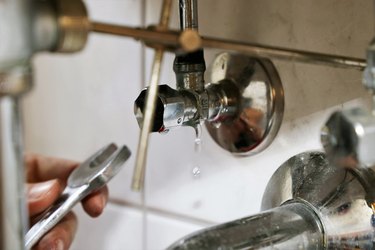
An escutcheon (pronounced "es-ketch-in") plate covers the gap between the pipe and the wall or counter. In kitchens, escutcheon plates may also cover unused holes in the counter meant for soap dispensers, air gaps or spray heads. Although they serve a practical purpose, the escutcheon plate also adds decorative flair to plumbing fixtures. Learn how to remove escutcheon plates to complete repairs or update the look of your sink or shower.
Common Escutcheon Adhesion Methods
Video of the Day
Escutcheon plates typically adhere to a surface with caulk or screws. The plumbing fixture may also provide enough force to hold the escutcheon plate in place. When planning how to remove the escutcheon plate, start by looking for screws going through the plate and into the wall. Use a screwdriver to remove these screws.
Video of the Day
If you don't see any screws, look around the outer edge of the escutcheon plate for a bead of caulk. Use a razor scraper to carefully lift this caulk and then wiggle the plate to check whether it has come loose.
Many modern sink faucets have a rubber gasket that sits under the escutcheon plate. You do not need to scrape this away, because it's held in place with the pressure of the faucet. Instead, remove the faucet handle to allow the escutcheon plate to slide up and over the faucet stem.
Removing the Escutcheon Plate
Regardless of how the escutcheon plate adheres to the wall, it will not slide up and over the plumbing fixture without at least partially removing the faucet handle or spout. To prevent any mishaps, turn off the water valve leading to the faucet. Then locate a screw holding the faucet handle in place. This screw can often be found under a decorative cap that can be gently levered off with a flat-head screwdriver.
Use a Phillips screwdriver or Allen wrench to loosen the screw until the handle lifts off. Test the escutcheon plate to see if it can slide over the other hardware at this point. If not, continue to take apart the faucet by removing the nuts holding the cartridge in place.
If the escutcheon plate is covering the gap where a length of pipe enters the wall, locate the nut closest to the escutcheon plate. Unscrew and loosen this nut to allow the escutcheon plate to slide off the pipe.
Installing a New Escutcheon Plate
Because pipes come in different sizes, escutcheon plates come in different sizes as well. Be sure to follow Plumbing Supply's tips to accurately measure for the correct size and type of pipe before you purchase an escutcheon. An escutcheon designed for 1/2-inch copper pipes will not fit a 1/2-inch galvanized steel pipe, so be sure to pay attention to all the specifications when buying a new escutcheon. When in doubt, bring the old one to your local plumbing supply store to find a match.
Slide the escutcheon over the pipe or faucet in question. If the escutcheon has screws, line up the holes in the escutcheon with the holes in the wall or mounting box and sink the screws with a screwdriver. If the escutcheon has no screws, secure it to the wall or counter using plumber's putty or caulk. Then reattach the pipes or the faucet handles and turn on the water valve.